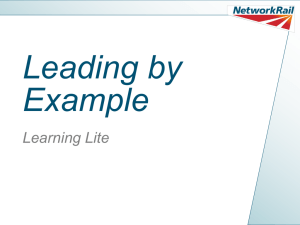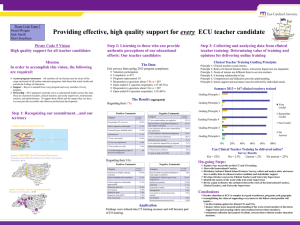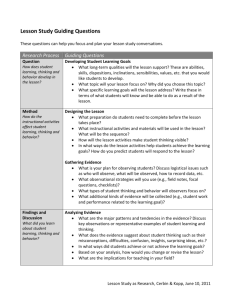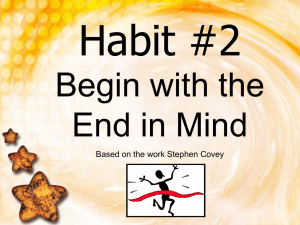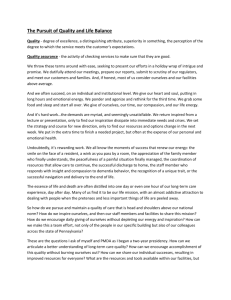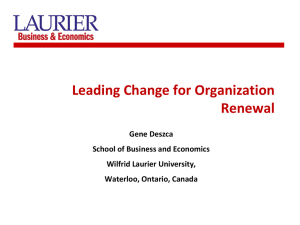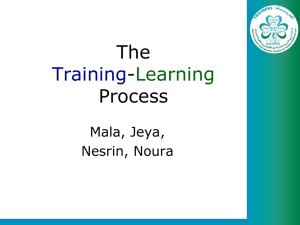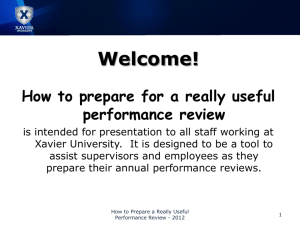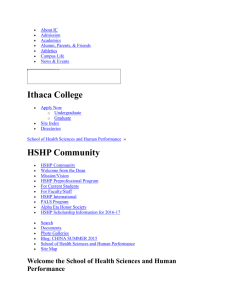Are We Building A Learning Organization?
advertisement
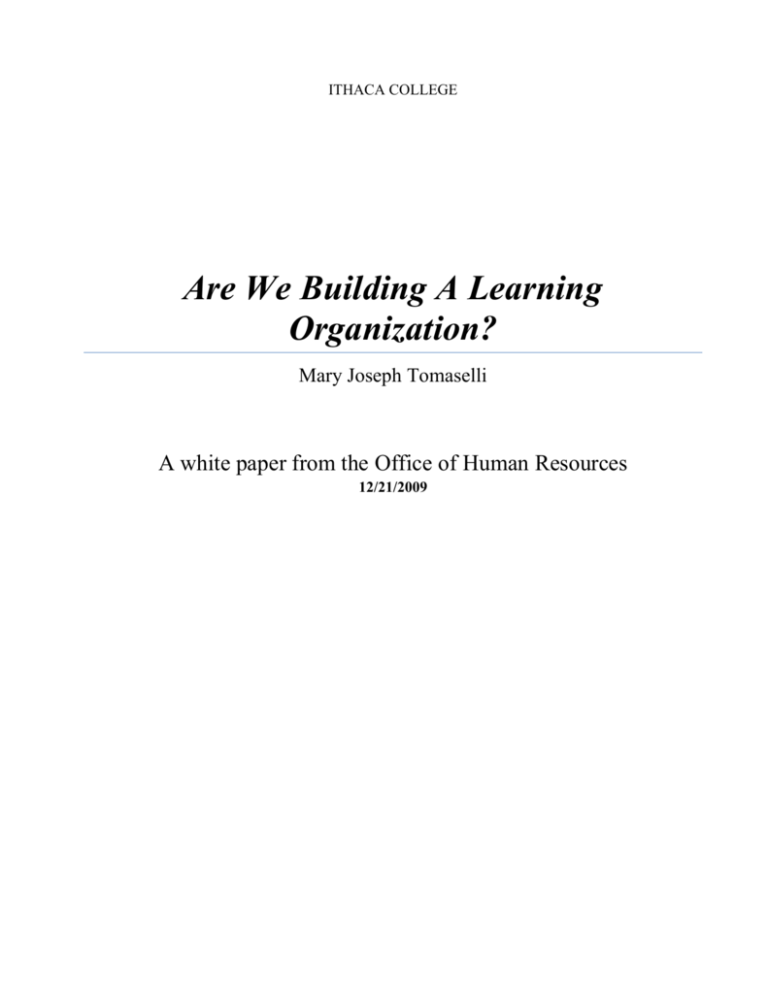
ITHACA COLLEGE Are We Building A Learning Organization? Mary Joseph Tomaselli A white paper from the Office of Human Resources 12/21/2009 Are We Building A Learning Organization? We are born with a desire to learn! Our intrinsic love of learning prompted our first step, triggered our first words, took us to the moon, and brought us advances in technology that boggle the mind. However, learning is not an event; it is a process of continuous improvement – a journey with no end. In the Chinese language, learning means “study and practice constantly.” Today’s economic climates, current financial woes, competitive pressures, advances in technology, employee mobility, expectations of life-work integration, and pressure from boards and constituencies to increase productivity and/or services have illuminated the need for organizations to be agile, adaptable change leaders. They must position themselves for predictable and unpredictable market conditions. The drivers of the organization, the employees, must be knowledgeable, skilled and deliver results. As stated by the owner of a company as his employees were leaving at the end of the day, “There goes my business … my company’s success.” Employees’ skills, knowledge and motivation determine an organization’s future. The success of both the employer and the employee lies in an appreciation for and commitment to continuous learning. Recognizing the impact learning has on an organization’s competitive advantage in terms of innovation, quality, and performance; organizations today are aspiring to become learning organizations. Two fundamental components are embraced by learning organizations. Firstly, a culture is created where attention to the learning process is as important as the learning. Secondly, it is understood that in order to strengthen performance, an organization’s strategy determines the learning objectives. In other words, learning initiatives must be linked to organizational goals. The Learning Process Whether learning is at the individual, team or organizational level, a learning organization is as conscious about the process of learning as it is about the learning. Referred to as the action learning cycle for continuous improvement, the process includes: the identification of a goal along with a plan for attaining that goal; implementation of the plan; gathering feedback on the progress (How are we doing? What’s going well? What’s not?); assessing and evaluating the progress; reflecting and making adjustments to the plan; and implementing the revised plan. While this process is going on, a learning organization also observes its behavior asking, “What are we learning about the way we are working together? What are we doing well? How can we improve?” Communication, dialogue, and collaboration are essential in the action learning model at the team and organizational level. Action Learning Model (Do-Review) Make a Plan/Implement Plan/Adjust Plan Reflect, Make Adjustments Get Feedback Assess/Evaluate 2 Creating a learning culture begins at the top. However, commitment and support for strategic learning activities are understood to be the responsibility of not only the leaders of the organization but of the managers, supervisors and employees as well. All employees are rewarded for learning through recognition, enhancement of job responsibilities, promotional opportunities or monetary reward. Steven Covey, author of The Seven Habits of Highly Effective People, suggests that organizations create a culture where every learner becomes a teacher and every teacher becomes a learner.1 Linking Learning to Organizational Strategy Training and development is both costly and important; therefore, organizations should strive to make every dollar invested produce desired results. With every training and development initiative and dollar spent, the question should be asked, “How does this effort help us attain our goals and advance the mission of our organization?” For example, how might teaching leadership skills to facilities attendants at Ithaca College advance the mission of the institution? Or, how does a supervisory development program help the College in modeling its guiding principles? Learning organizations tighten the link between education and business strategy (vision, mission, values, goals) when identifying and justifying training and development proposals, programs and initiatives. See Figure 1. The Learning Organization Organizational strategy drives organizational, departmental and individual goals. Strategic training and development efforts need to be aligned with these goals. Figure 1. Are we a learning organization? Peter Senge identifies the elements of a learning organization in his book, The Fifth Discipline: The Art and Practice of The Learning Organization. His framework is comprised of five disciplines that when pursued begin to separate the learning organization from the traditional, authoritarian, controlling organization.2 The resulting benefits are higher performance, innovation, creativity and goal achievement. He is also clear to state that like “excellence,” a learning organization is something that is pursued; yet, never fully realized. The five disciplines of this strategic learning model are: Systems Thinking, Personal Mastery, Building a Shared Vision, Team Learning, and Mental Models. Stephen R. Covey, “Teaching Organizations,” Executive Excellence (March 2000): 20. Peter M. Senge, The Fifth Discipline: The Art & Practice of The Learning Organization. 1994, Currency Doubleday, NY, NY 10036. 1 2 3 The following questions challenge us to reflect on the characteristics of a learning organization in order to assess our own culture. Are we building a learning organization? These questions can also be used to develop a series of metrics for the purpose of measuring our progress as a learning organization. 1) Do we collaborate (Systems Thinking)? Do we work together to support the organization? Do we support each other as individuals, departments, divisions, schools? Do we use a systems thinking approach when solving problems so that solving a problem for one group doesn’t create a problem for another? Do we share information, pass it along, or do we withhold it for fear that employees and/or constituencies can’t handle it? Do we share knowledge and resources or do we refrain, equating it with power or because we have a poverty mentality? Do we work together to solve complex organizational problems? Do we trust each other? 2) Does each of us strive to be the best he or she can be (Personal Mastery)? Is each one of us in our organization committed to continuous learning? Are we aware of our own personal values and how those values align with our organization’s mission and values? Is each of us excited and energized to be here; or, are some just putting in their time? Does the organization have spirit – does the presence of each of us bring life and energy? Do we show passion? Do we take risks? Does each employee initiate meaningful activity daily because the organization’s strategy is clear or do we wait to be directed or told what to do? Does each one of us have an individual development plan – a guiding map for our development aspirations? Are these plans developed with the help of our supervisors? 3) Do we know who we are, where we are going and how we will get there (Building a Shared Vision)? Does each of us know what our organization’s vision is? Does it foster genuine commitment? Are organizational values or guiding principles identified and modeled? Do we understand and support them? Are they communicated clearly, frequently? Do we as leaders model the way? Does each one of us have goals that align with the organization’s goals, vision and mission? Does each one of us understand how the work we do moves the organization toward its vision and goals? Do we reinforce learning, model what we teach, and provide opportunity to practice? Are conversations between supervisors and employees a frequent occurrence and expected by the organization? Is learning included in each job description? Is performance management linked to learning? Is learning linked to organizational vision, mission, values and goals? 4) Are we synergistic (Team Learning)? Do we model the old adage, “Two heads are better than one?” Do we communicate well with each other? Do we educate ourselves and our employees in the techniques of dialogue? Do we use these techniques? Are we empathetic towards others’ opinions and experiences? Do we have rich discussion in order to solve problems? Do we balance advocacy with inquiry – ask others for their thoughts and also express our own? Does working in groups lead to more and better ideas, actions, and possibilities than working alone? Are we respectful? Open? Nonjudgmental? Do we trust one another? Are we positive? Do we know how to give constructive feedback up and down the hierarchy? Do we practice giving constructive feedback? Are we educated in how to receive feedback? 4 5) Do we examine our own perceptions (Mental Models)? Do we look at our organization with fresh eyes and an openness to consider new or different possibilities or ways of being? Do we question practices, procedures, beliefs, assumptions? Is the importance of actively listening to one another taught and modeled? Do we view mistakes as learning opportunities? Are we forgiving? Are we open to change? Do we understand the stages of change and help each other move forward? Do we deal with an unwillingness to change as a performance issue? It would be easy to say we are a learning organization because we are an educational institution that provides and supports plenty of learning opportunities. That is not enough. Calendars of events, classes, and training programs do not make an organization a learning organization any more than wearing a cape and tights makes one Superman. To truly be a learning organization, one that thrives in today’s myriad of challenges while preparing for future unknowns, we have to turn the mirror towards ourselves and take a good, honest look. When the practice of asking ourselves the difficult questions becomes habit, and our reflection of our answers leads us to work together to change our behavior, actions and our mental models, then we can say, “We are building a learning organization.” 5
